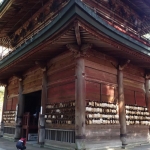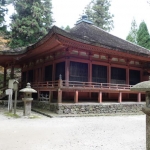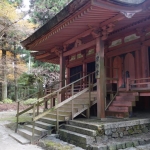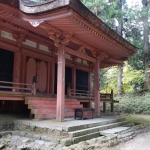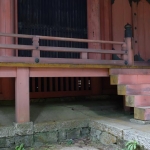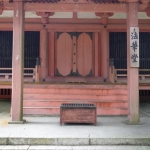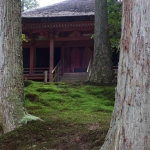Mount Hiei
autumn wind –
a figure
standing alone
–Ryokan
Red: Places of Interest Blue: Eat Green: Sleep
Mt. Hiei is the second highest mountain in Kyoto, at 848 meters (2,782 feet), and just a short distance northeast of downtown.
Located in Kyoto’s eastern mountain range on Mount Hiei, Enryakuji is one of the most important monasteries in Japanese history and the headquarters of the Tendai sect of Japanese Buddhism. Many influential monks studied at Enryakuji, including the founders of a number of later sects, such as the Pure Land (Jodo), Zen and Nichiren sects. At its peak of power there were over 3000 religious buildings scattered throughout the three sites. It was awarded with UNESCO world heritage status in 1994.
Enryakuji was founded in 788 by Saicho, the monk who introduced Tendai Buddhism from China into Japan. The Enryakuji complex was home to powerful armies of warrior monks who often engaged in power struggles with other monasteries and political leaders.
The priest named Saicho was given imperial permission to build a temple to protect the newly founded capital from the spirits of misfortune believed to come from the northeast.
Enryakuji, as this Tendai temple came to be called, grew into one of japan’s main centers of Buddhism. It became so vast and powerful that even the powerful eleventh-century emperor Shirakawa once said the the only things which he could not control were, “The roll of the dice, the Kamo River, and the monks of Enryakuji.
After the nearly three thousand temples and associated structures and inhabitants were destroyed by the famous warlord, Oda Nobunaga, in 1571, his successor, Toyotomi Hideyoshi, permitted Enryakuji to rebuild.
Only a few of the 3000 buildings survived which we can see today.
The temples on Mt. Hiei are collectively known as Enryakuji, which is divided into three sections: Eastern Pagoda, Western Pagoda, and Yokawa. The pagodas are long gone but the name remains.
Buses run between the three areas except for winter season. In winter, you can easily get to the To-do area, but to walk further 1km west to Sai-to and another 3km to Yokawa areas is not easy when there is a lot of snow on the ground.
At Konpon Chudo, the main hall of the temple, there is the Inextinguishable Dharma Light. The flame has been burning for some 1200 years, and there is always a monk by it, tending to it, to keep it alight while chanting the sutra.
Most of the attractions are in the Eastern Pagoda area. There is also a good museum there, the Kokuhoden Museum.
For a set pass that allows entrance into all of the temples and the museum, the fee is 1,000 yen.
I highly recommend visiting the Daikodo (Great Lecture Hall), the Kaidan-in and adjacent bell tower (visitors are welcome to strike the bell, but bells are not struck while still resonating, so still the clapper after striking), Kompon Chuda (the Central Hall of the Entire Enryakuji complex), the adjoined Jogyodo (Continuous Walking Hall) and Hokkedo (Lotus Hall) and Shakado (Shakyomuni Hall), which is the oldest building on the mountain. I think that you will feel transported back in time.
Hieizan, which straddles Kyoto and Shiga prefectures, offers a spectacular view of Japan’s biggest lake, Biwako. And for the energized who want to do more than look, there are numerous hiking paths.
With its eclectic offerings, Hieizan can please just about any tourist, be they interested in nature, culture or religion.
Getting there:
There are occasional direct buses from Kyoto station directly to the top, taking about 1.5 hours and all departing in the morning. Schedules are severely curtailed in the winter.
From Kyoto station, take the JR Kosei Line for four stops to the northeast. After getting off at Hieizan Sakamoto station, either walk 15 minutes or take a bus available only Sunday and Saturdays to the cable car station. The cable car runs every half an hour and takes about 15 minutes to the upper station where you can get the spectacular view of Lake Biwa, the largest lake in Japan. There you check the time of the last downward car, normally it’s 4:30 pm in December and 5 to 6 pm in the other months.
Another Option: http://www.keihan.co.jp/traffic/valueticket/global/en/pdf/hiei-hieizan_enryakuji_201703.pdf
I hope you will make time to catch the early morning bus from Kyoto Station like I did and ride up the mountain which is enjoyable in of itself. It is best to bring some food with you.
My walks in fall between the Toto (Easter Precinct) and the Saito (Western Precinct) were wonderful. There is a shuttle bus that makes a circuit of all areas. Do watch your time, so you are able to catch the bus back to Kyoto Station.
A good guide to take along is Exploring Kyoto by Judith Clancy.
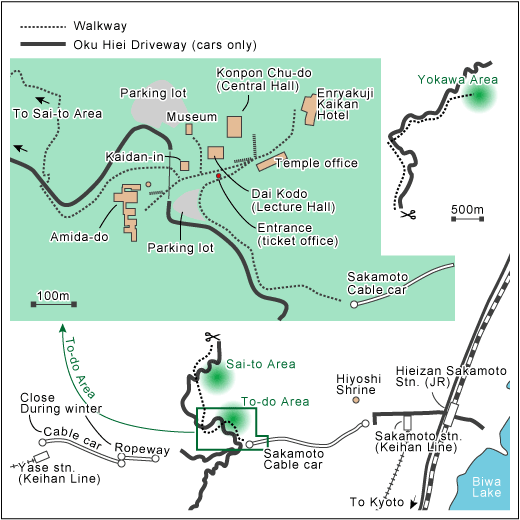
http://www.hieizan.or.jp/_att/english.pdf
Hiking route from Mt. Hiei to Sakamoto

This 6.7km (4.2 miles) ancient pilgrimage route offers a dynamic three-hour trekking experience through undisturbed natural scenery. Set out from the Hiei cable car station and walk the trail until Enryaku-ji Temple East Tower. From there, descend along the main hiking route until you reach Keihan Sakamoto station in neighboring Shiga Prefecture.


